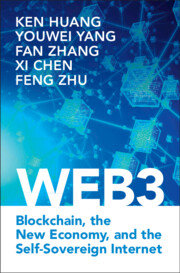Book contents
- Web3
- Reviews
- Web3
- Copyright page
- Contents
- About the Authors
- Foreword by Anthony Scaramucci
- Foreword by Yale Li
- Preface
- Acknowledgments
- Part I Foundations of Web3
- Part II Technological Underpinnings of Web3
- Part III Applications and Use Cases of Web3
- 6 The Tokenomics for Web3
- 7 DeFi and Next Generation of FinTech
- 8 NFT and Its Ecosystem
- 9 Decentralized Autonomous Organizations and Organization Formation on Web3
- Part IV Challenges and Future Horizons of Web3
- Index
- References
7 - DeFi and Next Generation of FinTech
from Part III - Applications and Use Cases of Web3
Published online by Cambridge University Press: 21 November 2024
- Web3
- Reviews
- Web3
- Copyright page
- Contents
- About the Authors
- Foreword by Anthony Scaramucci
- Foreword by Yale Li
- Preface
- Acknowledgments
- Part I Foundations of Web3
- Part II Technological Underpinnings of Web3
- Part III Applications and Use Cases of Web3
- 6 The Tokenomics for Web3
- 7 DeFi and Next Generation of FinTech
- 8 NFT and Its Ecosystem
- 9 Decentralized Autonomous Organizations and Organization Formation on Web3
- Part IV Challenges and Future Horizons of Web3
- Index
- References
Summary
Chapter 7 highlights key concepts in Decentralized Finance (DeFi) and compares it to traditional finance. It discusses major DeFi applications such as decentralized exchanges, lending/borrowing platforms, derivatives, prediction markets, and stablecoins. DeFi offers advantages, including open access, transparency, programmability, and composability. It enables peer-to-peer financial transactions without intermediaries, unlocking financial inclusion, efficiency gains, and innovation. However, risks such as smart contract vulnerabilities, price volatility, regulatory uncertainty, and lack of accountability persist. As DeFi matures, enhanced governance, security audits, regulation, and insurance will be vital to address these challenges. DeFi is poised to reshape finance if balanced with prudence. Important metrics to track growth include total value locked, trading volumes, active users, and loans outstanding. Research tools such as Dune Analytics, DeFi Llama, and DeFi Pulse provide data-driven insights. Overall, DeFi represents a profoundly transformative blockchain application, but responsible evolution is key. The chapter compares DeFi to traditional finance and analyzes major applications, benefits, risks, and metrics in this emerging field.
- Type
- Chapter
- Information
- Web3Blockchain, the New Economy, and the Self-Sovereign Internet, pp. 175 - 226Publisher: Cambridge University PressPrint publication year: 2024

